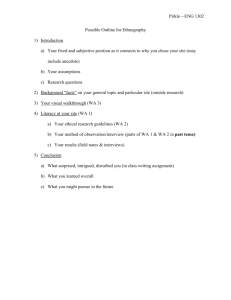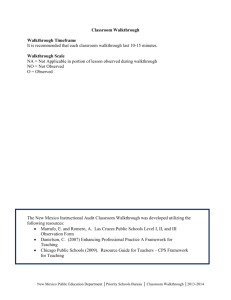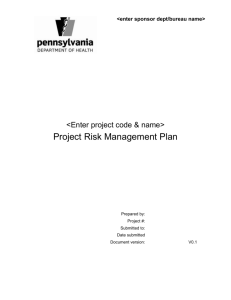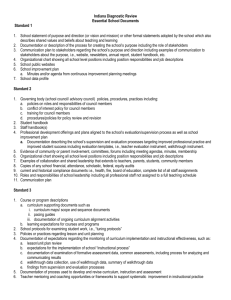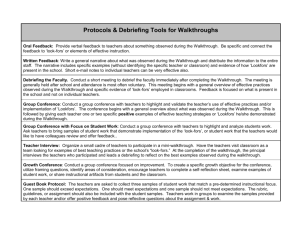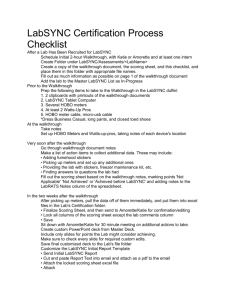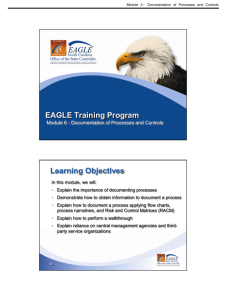Quality Assurance - Pennsylvania Department of Health
advertisement
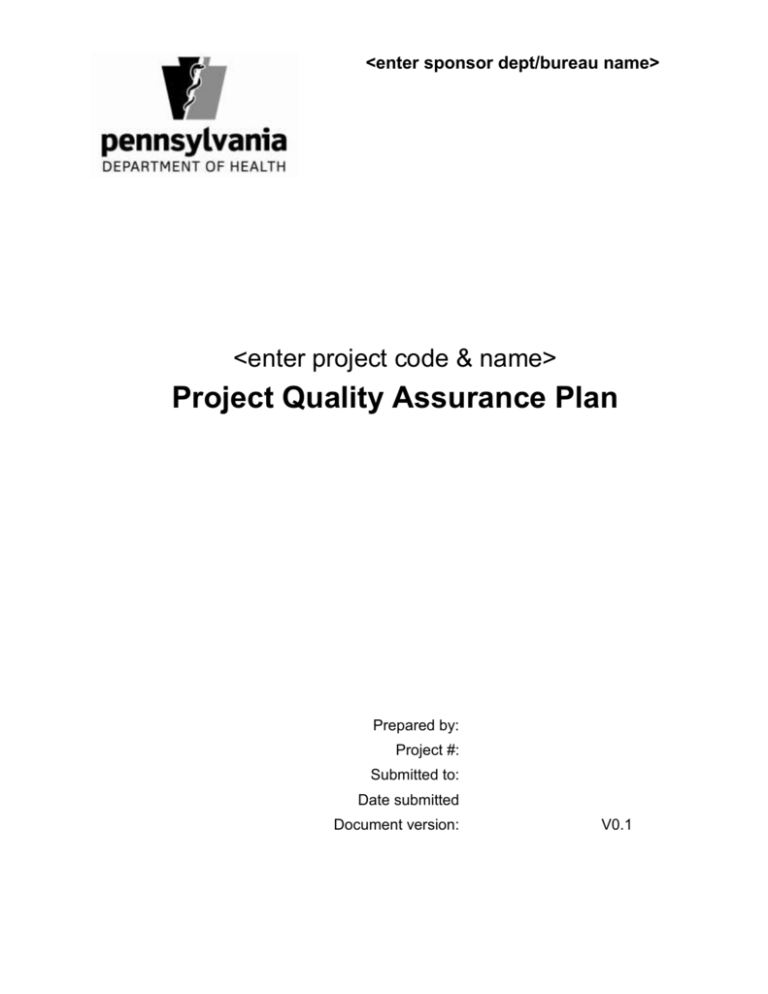
<enter sponsor dept/bureau name> <enter project code & name> Project Quality Assurance Plan Prepared by: Project #: Submitted to: Date submitted Document version: V0.1 Commonwealth of PA-Department of Health <enter sponsor dept or bureau name> Document Instructions <This document template contains directions for use or sample entries. These directions are enclosed in brackets (< >) and are italicized. They are included to help you fill out the form. As you complete the form, delete these instructions. Please follow this document naming convention to facilitate document search and retrieval: <project code (if appropriate)> <project name (abbreviated)> <document name (abbreviated)> <version (if appropriate)> All documents should be posted to the appropriate project folder in SharePoint. > Document History <The document history is a log of changes that are made to the document, who made the changes, and when. For example, the initial creation of the document may contain the following: Version 0.1, Date 1/1/2004, Author Charlie Brown, Status Initial creation. Subsequent updates to the document will be Version 0.2, 0.3, etc. The first published version of the document should be Version 1.0.> Version 0.1 1.0 Date Author Mm/dd/yy Mm/dd/yy Status Revision Descriptions Initial Draft First Published Approvals <In lieu of this Approval section, which requires multiple signatures on one document, you may elect to use the Approval Memo template. Distribute both the Project Quality Assurance Plan and the Approval Memo, requesting that only the memo be printed, signed and returned to indicate approval.> Your signature below indicates that this document meets its objectives and is acceptable. Signature Name Title Date Signature Name Title Date Signature Name Title Date Signature Name Title Date <enter project code & name> Page 1 of 18 Project QA Plan Commonwealth of PA-Department of Health <enter project code & name> Page 2 of 18 Project QA Plan <enter sponsor dept or bureau name> Commonwealth of PA-Department of Health <enter sponsor dept or bureau name> Table of Contents 1 PURPOSE OF THIS DOCUMENT ............................................................................ 4 2 ACRONYMS.............................................................................................................. 4 3 EXECUTIVE SUMMARY ........................................................................................... 5 4 INTRODUCTION ....................................................................................................... 6 4.1 4.2 4.3 5 QUALITY PLANNING ............................................................................................... 6 5.1 5.2 5.2.1 5.2.2 5.3 5.4 6 DEFINITION ....................................................................................................... 6 QUALITY STANDARDS ........................................................................................ 6 QUALITY TOOLS ................................................................................................ 6 INTRODUCTION .................................................................................................. 6 QUALITY MANAGEMENT/ASSURANCE PLAN.......................................................... 6 Product Quality ....................................................................................... 7 Quality of Service ................................................................................... 7 QUALITY METRICS ............................................................................................. 8 QUALITY CHECKLISTS ........................................................................................ 8 QUALITY ASSURANCE ........................................................................................... 9 6.1 6.2 6.3 6.4 INTRODUCTION .................................................................................................. 9 QUALITY ASSURANCE PROCESS ......................................................................... 9 QA & QC ACTIVITIES....................................................................................... 11 NONCONFORMANCE REPORTING ...................................................................... 11 7 QUALITY CONTROL .............................................................................................. 11 8 QA AND QC ROLES AND RESPONSIBILITIES .................................................... 12 9 ADDENDUM............................................................................................................ 12 9.1 9.2 10 STRUCTURED W ALKTHROUGH CHECKLIST ......................................................... 12 PROJECT COMPLETENESS AND CORRECTNESS CRITERIA ................................... 16 GLOSSARY OF TERMS ......................................................................................... 17 <enter project code & name> Page 3 of 18 Project QA Plan Commonwealth of PA-Department of Health <enter sponsor dept or bureau name> 1 Purpose of This Document Quality Assurance is the managerial process that determines the organization, design, objectives, and resources necessary to provide adequate confidence that a product or service will satisfy the quality requirements. The use of this plan will help assure that software development, evaluation, and acceptance standards are developed, documented, and followed by the project team. 2 Acronyms <Provide all acronyms that may be used within this document.> Table: Acronyms Used in This Document Acronym PMM <enter project code & name> Definition Project Management Methodology (example) Page 4 of 18 Project QA Plan Commonwealth of PA-Department of Health <enter sponsor dept or bureau name> 3 Executive Summary <In this section, provide a brief one-page summary describing the purpose, methods, issues, and results of the Quality Assurance Plan. This section should be completed last and should capture the key points described in the detailed section of this document.> [Enter the Executive Summary text here] <enter project code & name> Page 5 of 18 Project QA Plan Commonwealth of PA-Department of Health <enter sponsor dept or bureau name> 4 Introduction 4.1 Definition Quality management refers to the strategies used to control the quality of products and services that are delivered during project execution. The goals of quality management are to identify those quality standards that are relevant to the project, identify the strategies for satisfying those standards, and communicate them in order to promote their understanding and use. Specific processes are quality planning, quality assurance, and quality control. 4.2 Quality Standards <Determine whether the project will follow any quality standards that DOH has previously defined and list those standards. You may also reference a published standards document instead of retyping the standards on this section.> [Enter text here.] 4.3 Quality Tools <List any quality-related tools that this project will utilize.> [Enter text here.] 5 Quality Planning 5.1 Introduction Quality planning produces three outputs: Quality Management/Assurance Plan, quality metrics, and quality checklists. 5.2 Quality Management/Assurance Plan The purpose of quality management is to identify which quality standards are relevant to the project and to determine how to satisfy them. The overall project plan should account for quality by having it planned in, not inspected in. The project team performs this function of planning. The Department of Health’s PMO combines the Quality Management Plan and Quality Assurance Plan. Quality <enter project code & name> Page 6 of 18 Project QA Plan Commonwealth of PA-Department of Health <enter sponsor dept or bureau name> management strategies involve product quality and quality of services, as discussed below. 5.2.1 Product Quality Peer Reviews The goal of the Peer Review process is to control the degree to which project team members have followed the various applicable coding standards during development. Peer Reviews are conducted for all code modules that have been newly built or modified in response to a requirement. Structured Walkthroughs The goal of conducting Structured Walkthroughs is to raise and discuss issues surrounding development in response to the most complex and risk-laden requirements, and to bring the expertise of the entire development team to bear in resolving those issues. Requirements Traceability The requirements that are defined during the Planning Phase are subject to change throughout the subsequent project phases. Requirements Traceability provides a means of verifying that the product conforms to scope throughout each of the project phases. This is achieved by documenting the relationship between requirements, design elements, code modules, and system test scripts. Product Testing The goal of Product Testing is to validate that the product behaves as expected prior to implementation. The testing approaches are: Unit Testing, System Testing, Regression Testing, User Acceptance Testing, and Load/Stress Testing. Deployment Approvals The goal of Deployment Approvals is to provide the owner of the system with control over all changes to the system in the production environment. 5.2.2 Quality of Service Lessons Learned The goal of the Lessons Learned process is to retroactively review each project phase after it has been completed and gather feedback from project team members regarding how well the services delivered during that phase have met the objectives of the phase. <enter project code & name> Page 7 of 18 Project QA Plan Commonwealth of PA-Department of Health <enter sponsor dept or bureau name> Internal Peer Reviews The goal of the Internal Peer Review is to gather feedback from team members regarding a proposed project artifact and to incorporate that feedback prior to publishing the artifact for use on the project. External Stakeholder Reviews The goal of the External Stakeholder Reviews is to gather feedback from the project stakeholders and team members regarding a proposed project deliverable, and to incorporate that feedback prior to the completion of the deliverable. Management Reporting The goal of Management Reporting is to monitor the results of specific services delivered on the project, communicate those results among the project team, and identify any unsatisfactory performance that may require action by a member of the project team. 5.3 Quality Metrics Quality metrics are units of measurement used to assess, calculate, or determine quality assurance and control. <Describe below the metrics used for this project.> [Enter text here.] 5.4 Quality Checklists Quality checklists are structured tools used to verify that all steps in a process have been performed. They ensure consistency in frequently performed tasks. This project has developed the following checklists: Project Acceptance Criteria contained in the Project Charter. This checklist includes measurable statements that define when the project is complete. Project Completion Activities contained in each of the Closeout Phase Checklists. These activities are lists of all the tasks that must be completed for each phase. Structured Walkthrough Checklist contained in the appendices of this document. This checklist provides guidance on conducting a structured walkthrough. <enter project code & name> Page 8 of 18 Project QA Plan Commonwealth of PA-Department of Health <enter sponsor dept or bureau name> Project Completeness and Correctness Criteria also contained in the appendices of this document. This is a list of tasks which help to develop project acceptance criteria. <Describe below any checklists specifically developed for this project. > [Enter text here.] 6 Quality Assurance 6.1 Introduction Quality assurance is a consistent and structured process for measuring and continuously improving the quality of a project. It is the activity of making sure “the right things get done” rather than “things get done right.” The latter phrase defines quality control. 6.2 Quality Assurance Process The first step in the QA process is to determine the type of QA review and strategy to use. <If the guidelines below do not contain the appropriate type or strategy, revise them to suit your needs.> Table: Quality Assurance Review Types Type Plan Review Organization Review Methods or Technical Review <enter project code & name> Description Compares the plan against the customer requirements that it must satisfy to ensure that the plan includes appropriate items. Evaluates staffing, training, tools, and facilities to make sure they meet customer requirements. Evaluates the methodologies and procedures to ensure they are appropriate for the project. Page 9 of 18 Project QA Plan Objective To make sure the plan will produce products that conform to requirements. To certify that the organization is able to address the needs and requirements of the project. To certify that the methodology and procedures will produce products conforming to customer requirements or to identify future modifications to the Examples Project plan review Unit test plans review Non-program component test plan review Design documents <vendor> project team review Customer project team review System life cycle review Project metrics review Commonwealth of PA-Department of Health Type Description <enter sponsor dept or bureau name> Objective methodology and procedures. Examples Table Quality Assurance Strategy Reviews Strategy Self-check or Desk-Check Peer Reviews Informal Walkthroughs Formal Walkthroughs Audits Description An individual’s review of their own work against requirements to evaluate conformance. A peer’s review of work against requirements to evaluate conformance. A critique of system construction or documentation by selected people at any stage in the project. No formal records or meetings are necessary for the walkthroughs. A group review of a document or product at or near the completion of each stage of the project. An independent inspection, which includes examining requirements, products, and control procedures, conducted by someone that is not associated with the project team. A QA project team member could also perform this audit. <Below is a sample matrix listing the type of strategies used for various QA reviews. They should be revised to suit the needs of your project.> Table: QA Reviews & Strategy Matrix Review Type Plan Review Project plan Unit test plans Non-program component test plan Design documents Organization Review <vendor> project team review Customer project team review Methods/Techniques Review Programming standards Project metrics <enter project code & name> Page 10 of 18 Strategy Used Formal walkthroughs Audit Self-check Peer reviews Self-check Peer reviews Self-check Peer reviews Formal walkthroughs Frequency Twice a month As needed As needed As needed Formal walkthroughs As needed Formal walkthroughs As needed Informal walkthroughs Audit As needed As needed Project QA Plan Criteria for Pass/Fail Commonwealth of PA-Department of Health 6.3 <enter sponsor dept or bureau name> QA & QC Activities <List the major quality assurance activities that this project will perform. Areas to consider for QA/QC focus include: Project status reporting Technical reviews Walkthroughs Testing processes Configuration & change control procedures Project documentation reviews Audits Business requirements verification Continuous improvement processes Other quality processes After quality assurance activities are identified and approved, they should be added to the project schedule. > This project has included the following quality assurance activities in the project work plan: Table: Quality Assurance Activities Activity ID 1 2 3 6.4 Nonconformance Reporting A nonconformance is defined as any deviation of a product or process from applicable requirements, standards, or procedures. These deviations can be inferred from analyzing the Test Results Log Table. Nonconformance items should be tracked on the Nonconformance Tracking Log --- available in the PMO template library. The purpose of this report is to record, assign priorities, and track corrective action for any discrepancies. The need for nonconformance and corrective action arises early in the software life cycle, as soon as the first documents and other products are developed. 7 Quality Control <enter project code & name> Page 11 of 18 Project QA Plan Commonwealth of PA-Department of Health <enter sponsor dept or bureau name> Quality control involves monitoring of specific project results to determine whether they comply with relevant quality standards and identification of ways to eliminate causes of unsatisfactory performance. This should be done throughout the project. Tools and techniques used for Quality Control include cause and effect diagrams, control charts, flowcharting, histograms, Pareto diagrams, statistical sampling, and defect repair reviews. 8 QA and QC Roles and Responsibilities The quality planning process also includes identifying the roles and responsibilities of the project team members. The table below defines these roles and responsibilities. Table: QA & QC Roles & Responsibilities Role Quality Assurance Responsibilities Project Manager Project Quality Reviewer(s) Project Sponsor Protect Team Members <Provide other roles & responsibilities as needed.> 9 Addendum <In this section add any additional information relevant to this document’s subject matter. > 9.1 Structured Walkthrough Checklist <A structured walkthrough is an organized procedure for a group of peers to review and discuss the technical aspects of software development and maintenance work products. The major objectives in a structured walkthrough are to find errors and to improve the quality of the product. Errors typically occur as omissions or contradictions, flaws in logic, or inconsistencies in the work product style (e.g., poorly stated requirements and inefficient code). Structured walkthroughs should not be used to discuss solutions for the errors that are found. The basic purpose of a walkthrough is error detection, not error correction. When the walkthrough is finished, the author of the work product is responsible for taking the necessary actions to correct the errors. > Prior to the structured walkthrough session: <enter project code & name> Page 12 of 18 Project QA Plan Commonwealth of PA-Department of Health <enter sponsor dept or bureau name> <Use the list below as a guideline for preparation for structured walkthrough sessions. Revise as needed for the specific project. Both the project team and the customer should agree on the preparation steps. > Where possible, access to the deliverable to be reviewed will be provided at least three days prior to the walkthrough session. Participants will be requested to review the deliverable and note any errors or defects in the product. Appropriate support materials (such as flow charts) will be prepared to assist reviewers with their understanding of the entire work product and how the segment being reviewed fits into the entire product. Reviewers will be asked to insert comments and questions directly on the review materials. Reviewers will also be asked to note directly on the review materials any non-technical errors found during the review, such as spelling or typographical mistakes. While these errors are not discussed during the walkthrough, they should be provided to the author at the conclusion of the walkthrough. Walkthrough sessions will not exceed 2 hours in duration. If more time is necessary, the work product segment will be divided into smaller portions and each portion reviewed separately. At the structured walkthrough session: <Use the list below as a guideline for structured walkthrough sessions. Revise as needed for the specific project. Both the project team and the customer should agree on the steps. > Walkthrough sessions will begin with a brief overview of the work product. The overview will be followed with a review of outstanding issues from previous walkthrough(s). Discussion will be limited to the identification of errors. The discussion of solutions is not part of the walkthrough process. The author's participation will be limited to observation and answering questions. At the conclusion of the session, reviewers will decide the status of the work product as follows: A - Accept product as is B - Revise--no further walkthroughs for this product C - Revise and schedule another walkthrough A majority opinion decides the action. If a majority opinion or consensus cannot be <enter project code & name> Page 13 of 18 Project QA Plan Commonwealth of PA-Department of Health <enter sponsor dept or bureau name> reached, the project manager and lead customer representative in the session will make the decision. If another walkthrough is necessary, the entire structured walkthrough process will be repeated. After the structured walkthrough session: <Use the list below as a guideline for actions to follow a structured walkthrough session. Revise as needed for the specific project. Both the project team and the customer should agree on these actions. > A Structured Walkthrough Management Summary Report will be completed. The report will include the following information: o Description of the work product reviewed. o Description of findings. In addition to findings, include significant problems that would cause schedule slippage or project cost increase. o Date, time, and duration of the walkthrough. o List of attendees. o Status decision (i.e., accept as is, revise--no further walkthrough, or revise and schedule another walkthrough) and any other follow-up activities. <enter project code & name> Page 14 of 18 Project QA Plan Commonwealth of PA-Department of Health <enter sponsor dept or bureau name> Structured Walkthrough Management Summary Report Project Name: Module and/or Release Number: Walkthrough Date: Work Product (check one) ___ Strategy Study ___ Prototype ___ CoP Budget ___ Functional Specification ___ Procurement Plan ___ System Specification ___ Benefit / Cost Analysis ___ System Design ___ Project Charter ___ Data Dictionary ___ MS Project Work Plan ___ Program and Interface Standards ___ Risk Management Plan ___ Logical Model ___ Communication Plan ___ Physical Model ___ Business Requirements Document ___ Installation Plan ___ System Test Plan ___ Source Code (Module xyz) ___ Acceptance Test Plan ___ Disaster Recovery Plan ___ User Guide ___ Conversion Plan ___ Training Materials ___ Maintenance Plan Description of Product Reviewed: Reviewers: Summary of Findings: (Include significant problems that would cause schedule slippage or project cost increase) Decision _______: A = Accept product as is B = Revise--no further walkthrough for this product C = Revise and schedule another walkthrough Circle or enter the appropriate letter: <enter project code & name> Page 15 of 18 Project QA Plan Commonwealth of PA-Department of Health 9.2 <enter sponsor dept or bureau name> Project Completeness and Correctness Criteria <The Completeness and Correctness Criteria section allows you to work with the customer up-front to define what it means for a deliverable to be considered complete and correct. Then, when you meet those terms, you would expect that the customer would indeed be happy. If you define the criteria and expectations up front, you will be much better able to meet the customer’s expectations. In other words, there should be no surprises. The Completeness and Correctness Criteria vary depending on the actual deliverable being produced. The templates give some examples of areas to consider, but each team will need to fill in the details based on their project. There should be one section in the table for every major deliverable that needs to be approved and one section that defines the acceptance criteria for the entire solution. The form contains a column for each acceptance criteria, a column for the expectations, and a column for the actual results. Each core deliverable on the project should be listed along with the agreed to completeness and correction criteria. When the deliverable meets the stated criteria, the customer would sign off on the last page, signifying that they accept the deliverable as is. This table contains examples of completeness and correctness criteria. Remove the examples and replace with your own criteria as appropriate.> Table: Project Completeness & Correctness Criteria Criteria TARGET Examples for an IT Application Major Features and Functions in Place Response Time Well Documented Secure Minimal Defects Overall Appearance Accurate Ease of Use <enter project code & name> Page 16 of 18 All high-priority requirements are met. At least 80% of the mediumpriority requirements are met. The users must not have to wait for normal response. Average response time less than one second, with peak times not more than five seconds. User documentation created and accepted. System documented within each program. All security requirements met. No more than five minor errors during user acceptance tests. No major errors during user acceptance test. At least a four out of five rating from the system test/usability test. All reports and online screens are consistent and balance. At least a four out of five rating from the system test/usability test. Project QA Plan Actual Commonwealth of PA-Department of Health Criteria <enter sponsor dept or bureau name> TARGET Must be up for a two-week trial run before going live. The system can be down for no more than 30 minutes during that timeframe. Available Examples for Project Document Table of Contents All Major Sections Complete TOC must exist. All major sections must exist, consistent with the standard document template. Run spell check and syntax check. No Grammar or Spelling Errors Easy to Read Conclusion Supported by the Facts Attachment for Financial Details Attachment for Work plan Details Subjective, based on reader verbal feedback. Subjective, based on reader verbal feedback. The financial details are included in a separate attachment. The work plan is included as a separate attachment. 10 Glossary of Terms <Include all terms that may not be familiar to the reader.> Term <enter project code & name> Table: Glossary of Terms used in This Document Definition Page 17 of 18 Project QA Plan Actual
